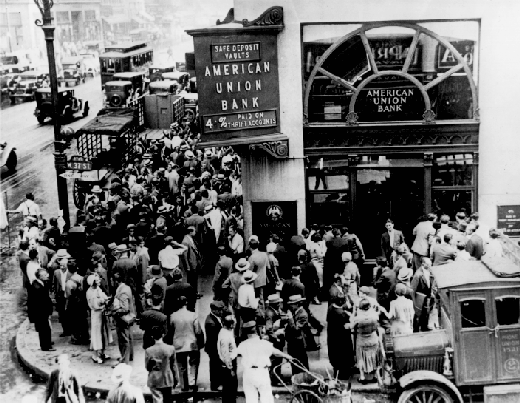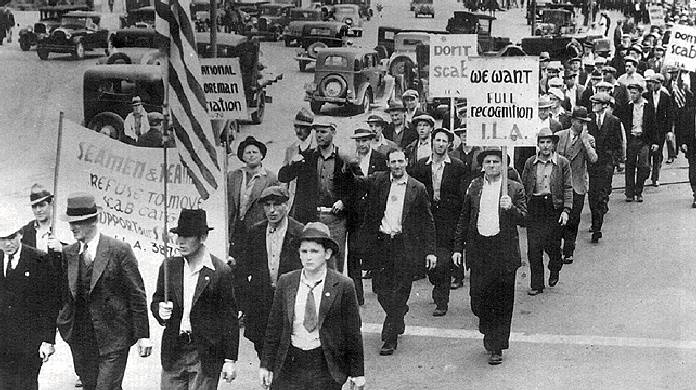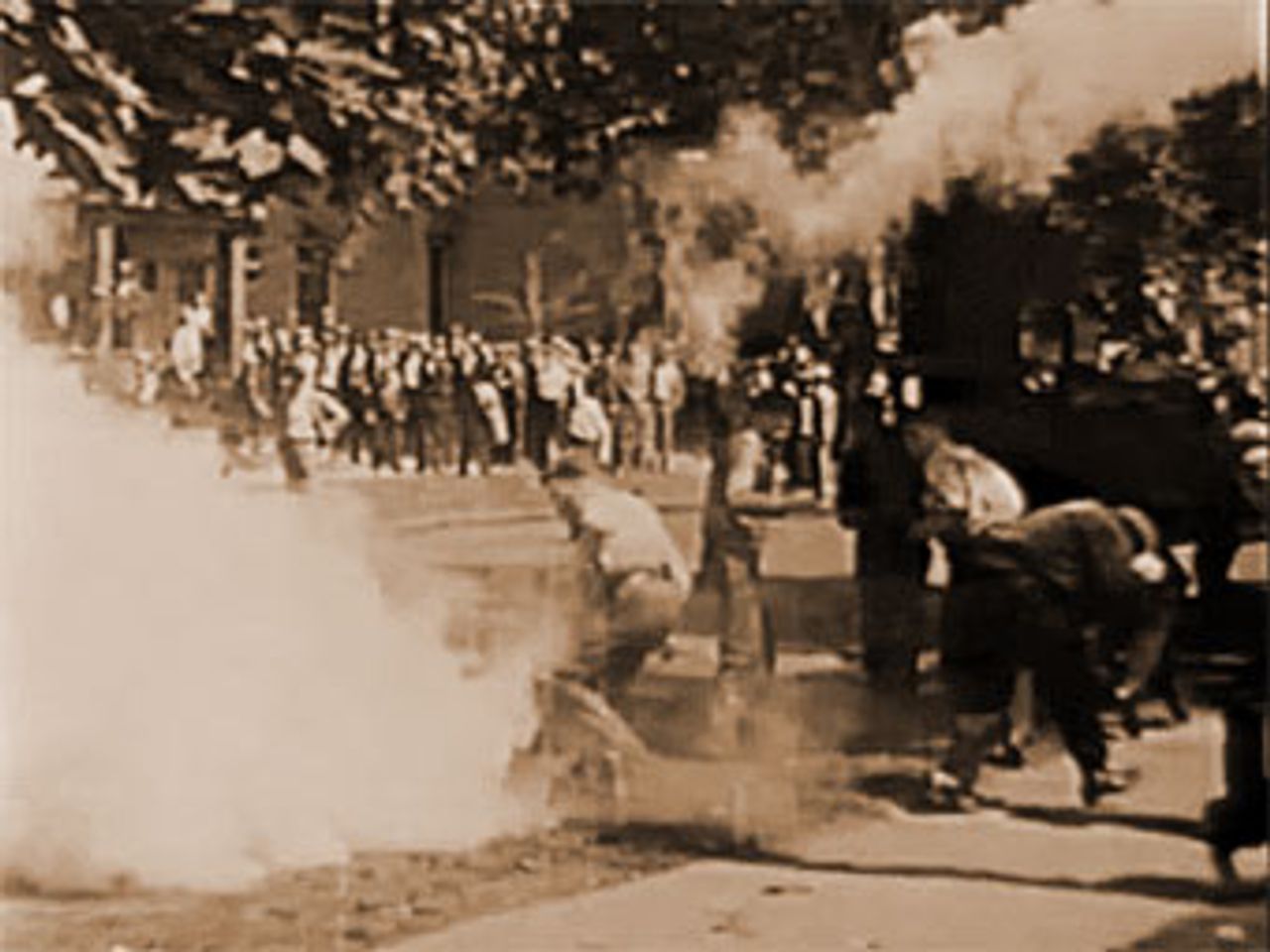I) First 100 Days – this has often been treated by historians as the implementation of the Roosevelt “plan;” however, Roosevelt operated during this time period without any plan, and often under conflicting advice from his advisers. Most of the actions taken during these 100 days were forced upon the administration by events.
A) March 1933 Bank Holiday – the first action that Roosevelt took during his administration was to order all banks closed to prevent a “run.” Banks were allowed to reopen when they were able to prove that they were solvent. While this sounds like a very drastic measure, it should be pointed out that 36 states had already closed the banks they chartered (and at this time there were only 48 states). This caused some temporary hardships, but as banks reopened they did so with the assurance that they were solvent—and thanks to the insistence of Michigan Republican Arthur H. Vandenberg, the federal government now protected bank deposits up to $2,500 through the predecessor of the Federal Deposit Insurance Corporation (FDIC).
B) Fireside Chats – FDR became the first president to regularly use the radio to communicate with the American people. FDR used a friendly, conversational tone on the radio, and many people came to look upon the president as a personal friend, someone who was interested in their welfare. Because he also came to embody the government, many people came to see the government as directly interested in their welfare, as well.
C) “Alphabet Agencies” – these agencies were populated with young Jewish and Catholic intellectuals, who were largely unwelcome in the Protestant-dominated business world.
1) Federal Emergency Relief Administration (FERA) – the agency charged with providing funds for the unemployed. Although the agency did hand out direct relief, much of the relief that people received they had to work for.
2) Civilian Conservation Corps (CCC) – largely served young adult males; moved city boys into the country (away from those corrupting influences) to work on conservation projects.
3) Civil Works Administration (CWA) – small scale public works projects, mainly road-building.
4) Agricultural Adjustment Administration (AAA) – implemented a whole series of laws and policies to assist farmers; restored “parity”; government made payments to farmers for NOT planting crops, which acted to decrease the supply and force prices upward. The timing of the implementation of this piece of legislation meant that many farmers had to destroy crops that were already planted as well as livestock.
(a) Who benefited? – most of the benefit of these policies went to larger and corporate farmers, who could take more land out of cultivation
(i) Southern Tenant Farmer’s Union – formed to protest this development; it was a bi-racial group, which of course was threatening to those in power in the South, and therefore was swiftly and violently put down (evictions, and attacks on road side camps)
5) Public Works Administration (PWA) – funded larger building projects, like University Hall and the Glass Bowl, as well as much of the expansion of the Toledo Zoo, and eventually a new public library.
6) Tennessee Valley Authority (TVA) – provided flood control for the Tennessee Valley (the Tennessee River flows northward from Alabama, through Tennessee and Kentucky to the Ohio River); the dams for this flood control also brought cheap electricity, which attracted industrial development in the area as well.
7) National Recovery Agency (NRA) – perhaps the most famous of the alphabet agencies was the NRA. What the NRA proposed to do was to foment the development of cartels in the USeconomy—that is, to encourage the formation of monopolies. It was thought at the time that this would help stifle cut-throat competition, because companies would be allowed to collude together to fix prices and divide the market between themselves.
(a) Section 7a – in return for being allowed to form cartels, businesses were to allow employees to join unions “of their own choosing.” This section was ambiguous on the point of whether these had to be independent unions, or whether they could be company unions. United Mine Workers president, however, sent organizers into the field with the message that “The President wants you to join the union.”
(b) The NRA was overturned by the Supreme Court, and was the impetus for Roosevelt’s attempt to “pack” the Supreme Court (which had to this point blocked much of the New Deal legislation).
(c) The NRA, headed by the mercurial (and possibly unstable) Gen. Hugh Johnson, had largely failed before it was killed by the Supreme Court. Compliance to the NRA codes was largely voluntary, and therefore businesses often failed to comply. Additionally, the union provision proved unsatisfactory to both businesses (who were, for the most part, extremely reluctant to work with labor unions) and labor (who were disappointed that Section 7a allowed the creation of company unions to compete with them).
II) Three Strikes
A) San Francisco Longshoremen’s Strike
1) Grievances
(a) The shape-up – longshoremen at this time were hired like day-laborers; they showed up at dock gates in a port, and the hiring boss chose those he was disposed to choose. If workers provided him with a reason to choose them (connections, bribes, kickbacks on the wages they were to receive that day), they were, of course, more likely to be chosen. The most important battle as far as the workers were concerned was to gain control of hiring practices (known as the hiring hall) so that they could control who would be sent to what job.
(b) Master agreement – workers demanded that all shipping firms agree to the same terms of contract, so that all workers on the west coast would be treated the same, and so that workers in other ports could not be used to whittle away the gains others might make.
2) International Longshoremen’s Association (ILA) – the ILA was the nominal union on the west coast, although its influence was flagging during this time; its real source of power was its control of the ports on the east coast, and on the Gulf coast. The ILA was led by a man named Joe Ryan, one of the most spectacularly corrupt union officials in history; as the strike on the West Coast dragged on, he flew in and attempted to make a separate peace in each port, rather than the master agreement that was one of the demands of the workers; only the longshoremen of Seattle gave in to this ploy, however.
(a) Harry Bridges – the leader of the San Francisco local was named Harry Bridges. Originally from Australia, Bridges was a brilliant organizer. Although he was probably a member of the Communist Party, he unfailingly put the interests of his members first (although this did not stop efforts by the US government to try and deport Bridges for much of the next forty years as an undesirable alien).
3) Battle of Rincon Hill – on July 5, San Francisco police attempted to put an end to the city’s portion of the longshoremen’s strike by attacking pickets at Rincon Hill, killing two and injuring 109 others. This blatant favoritism by the police led to workers in the city to call for a general strike, which took place for the following two days. Workers took over many city functions during that time period—directing traffic, etc. The international office of the AFL, however, demanded that the San Francisco CLU end its support for the general strike, which they almost immediately did and the strike quickly ended.
4) Settlement –the longshoremen’s strike went on for another three weeks after this, however, ending on July 31, after 11 weeks, with an agreement to arbitration on the outstanding issues. Through vigorous job actions over the next year or so, however, longshore workers were able to gain most of their demands.
B) Minneapolis Teamster’s strike
1) Citizen’s Alliance – an alliance of business citizens, that is. This group of business leaders was determined to keep Minneapolis a bastion of the open shop.
2) Teamster’s Local 574 – led by a group of militant truck drivers who had been expelled by the Communist Party in 1928—namely the three Dunne Brothers (Vincent, Grant, and Miles) and Karl Skoglund—who were determined to organize truck drivers in the city.
(a) February 1934 Coal Driver’s Strike – the first blow to the Citizen’s Alliance leadership in the city was this strike; obviously, a great number of Minneapolis residents needed coal in the middle of February. The quick success of this strike made the organization of other truck drivers and warehouse workers much easier; by the middle of May the local boasted of over 5,000 members.
(b) May 1934 strike – called after employers refused to bargain with the union; many members of the Citizen’s Alliance were deputized. The Teamster local’s Woman’s Auxiliary was also involved in the strike; when this group was attacked by the police and five members were sent to the hospital, 35,000 building trades members declared a sympathy strike, with the city’s CLU supporting the decision. After several bloody battles, the employer’s group agreed to bargain with union.
(c) July 1934 strike – the union distrusted the employer’s association, and began almost immediately to prepare the membership for another strike, which came July 16. The crux of disagreement was jurisdiction over so-called “inside” workers (inside the warehouse, that is). Teamster’s Local 574 wanted to transcend craft unionism and move toward industrial unionism, which the employer’s association opposed—as did the union own international president, Dan Tobin.
(i) “Bloody Friday” – small group of “flying pickets” were ambushed by the Minneapolis police (as an investigation by Minnesota governor Floyd Olson proved), with the result that two of the pickets died. Some 40,000 workers marched in the funeral procession for their two stricken comrades.
(ii) Government arbitration – the arbitrators sent in by the government were distrusted by Local 574, and proved to be ineffective.
(d) Settlement – on August 22, the employers association agreed to union representation of inside workers, and all other union demands.
C) Toledo
1) February 1934 – strike effecting Spicer Manufacturing, Bingham Stamping, Logan Gear, and Electric Auto-Lite was called by Local 18384, a Federal Union, a sort of temporary union created by the Toledo Central Labor Union to begin organizing Toledo autoworkers.
(a) Little initial support at Auto-Lite – only 15 workers at the Auto-Lite plant joined the picket lines in February; only the solidarity of the workers at the other plants, and their refusal to go back to work without their fellow union members at the plant, got the Auto-Lite management to agree to take back the strikers and “bargain” with the union.
(b) Section 7a – (read the clause from page 15 of Korth book); “guaranteed” workers to choose a union, and to bargain collectively (the NIRA code gave manufacturers the right to set prices and production quotas amongst themselves, in return). Management attempted to meet this requirement by encouraging company unions; workers resisted this push, and attempted to establish unions under their control. In all three strikes, the main push for the workers was simply that management recognize the union as their bargaining agent.
2) Auto-Lite bargaining tactics – essentially, to stonewall the union in the hope that it would eventually fade away. Instead of bargaining in good faith, as the company had indicated that it would, they instead hired more workers, in order to expand the pool of trained strikebreakers, in the anticipation that another strike would follow in the immediate future.
(a) C.O. Miniger – owner and manager of the company since the company had moved to Toledo from Indiana to supply headlamps for Willys automobiles. Sat on the board of directors of the Commerce Guardian Bank; when this bank failed in 1933, he used an advanced warning to pull out the money of his company and his own personal accounts, while thousands of ordinary Toledoans lost their savings in the failure of the bank.
(b) Tear gas – the company also bought a large quantity of tear gas, in anticipation of trouble that would follow
3) Congress for Progressive Labor Action (CPLA) – later known as the American Workers Party (AWP), which still later became the Workers Party. This group was led at this time by A.J. Muste, a (then) former Dutch Reformed Church minister; this organization was peopled with believers in Leon Trotsky’s “permanent revolution” (as contrary to Josef Stalin’s “revolution in one country”), left-wing socialists who believed that the economic distress of the country gave them a ripe opportunity to overthrow the capitalist system of the country (a belief which many capitalists shared).
(a) Lucas County Unemployed League – formed in late 1933 to begin organizing the unemployed in the county (mainly in the city of Toledo). They accomplished this by using such tactics as a “death march,” where a group of unemployed marched slowly around the county courthouse, pulling a wagon with a bell sounding the death knell; and by taking groups of unemployed into restaurants and insisting the owner send the bill to the Lucas County commissioners.
4) Second Auto-Lite Strike – concentrated upon the Auto-Lite and two affiliated plants; Bingham Stamping, and Logan Gear, both of which were partially owned by Miniger as well.
(a) April 13 – pickets set up after the membership of the local voted to strike the night before; approximately 400 workers from the plant walked the picket line, while about the same number of workers crossed the picket line initially. Picket line numbers were increased by the participation of other union members, and by the participation by members of the LCUL.
(b) Injunction – strikebreakers were being roughed up, verbally abused, and intimidated (followed, sometimes up the steps of their homes). On May 3, company lawyers asked for, and received from Circuit Court judge Roy R. Stuart, a sweeping injunction, limiting the number of pickets to twenty-five, and preventing the participation by anyone who had not been an employee of the Auto-Lite. The immediate result of this was that the number of strikebreakers who reported for work greatly increased, allowing the company to run full production, and essentially defeating the strike.
(c) Violation of the injunction – at the suggestion of Louis Budenz (later a member of the Communist Party, and later still a born-again Catholic and FBI informer), the members of the LCUL announced, in an open letter sent May 5 to Judge Stuart, that they were going to violate the injunction—which they began the next day. The members (rather small at this early time) were promptly arrested, and brought before Judge Stuart, where they were admonished not do that anymore, and released—whereupon they promptly left the courtroom and marched back to the plant to begin picketing once again. This action encouraged other members of the LCUL to join in. They would get arrested, raise hell at the courthouse, and be released, only to head back to the picket line. This “street theater” began to attract large crowds in front of the factory—and more importantly, began to diminish the number of strikebreakers to cross the picket line.
(d) Community uprising – by May 23, more than 10,000 people, men and women, were on the picket line surrounding the factory. Deputized plant security was on the roof with tear gas. A female picket was struck on the head with an object thrown from the upper floors of the factory; workers responded with a barrage of bricks that continued through the night. At midnight, the Ohio National Guard was mobilized; by the end of the six-day disturbance, this would be the largest peacetime mobilization in Guard history. The disturbance only ends when Ohio governor White promises not to use the Guard to re-open the factory; with the factory finally closed, Auto-Lite management agreed to negotiate with the union.
D) Southern Textile Workers strike – although valiantly fought by southern workers, the dispersed nature of textile workers communities meant that they received little help in their strike, which led to its failure.
E) Labor successes – the three successful strikes of 1934 succeeded because the workers conducting the strike were able to rely upon other workers in the community—something the textile workers in the South, because of their isolation, were not able to do. Although workers were certainly inspired by section 7a, and by FDR’s apparent positive response to labor, they did not rely upon the government to help them win their battles against employers – a lesson that the CIO did not learn.














No comments:
Post a Comment